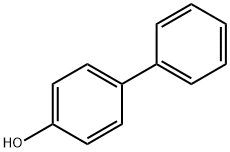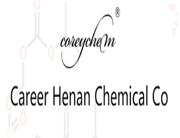| Chemical properties |
P-phenyl phenol appears as a white flake solid; being tasteless; mp:159 ~ 160 ℃; pure product has a mp of 166 ℃, a bp of 323 ℃, a relative density of 1.24. It is almost insoluble in water, but easily soluble in organic solvents such as alcohol, ketone and ether and alkaline solution. |
| Uses |
Biphenol, also known as p-phenyl phenol, is the intermediates of the fungicide bitertanol.It is used in the synthesis of oil-soluble resin and emulsifier; used as a component of corrosion-resistant paint, printing and dyeing carrier. |
| Uses |
It can be used as an intermediate for dyes, resins and rubbers. The red light sensitization and green sensitizing dye manufactured by this product is one of the main raw materials of color film; it can also be used as analytical reagents. |
| Preparative Methods |
- Separation of the byproducts of phenol produced by sulfonation method
The byproduct during phenol production by sulfonation is subject to distillation with the residue containing p-phenyl phenol and o-phenyl phenol. The residue is heated by the vacuum distillation with the vacuum degree being controlled at 53.3 to 66.7 kPa. The temperature is gradually increased from 65 to 75 DEG C to over 100 DEG C, but not higher than 135 ° C. Then apply separation based on the different solubility of p-phenyl o-phenol in trichlorethylene, that is, the mixed phenyl phenol was heated to be dissolved in trichlorethylene; then after cooling, it undergoes precipitation to generate p-phenyl phenol with filtering and drying to get the final product.
- Biphenyl sulfonated alkali melting method
The biphenyl dissolved in acetic acid, subjecting to sulfur trioxide sulfonation; after the separation of the sulfonation products, it is reacted with the 20% NaOH aqueous solution to form salt, followed by alkali melting with solid NaOH at 100 ~ 350 ℃, then further being acidified to obtain the product. |
| Chemical Properties |
light tan solid (odour threshold detection limit 0.7 ppm) |
| Definition |
ChEBI: A member of the class of hydroxybiphenyls that is biphenyl carrying a hydroxy group at position 4. |
| Uses |
As intermediate in the manufacture of resins; also in the rubber industry. |
| Purification Methods |
Crystallise the phenol from aqueous EtOH, *C6H6, and dry it in a vacuum over CaCl2 [Buchanan et al. J Am Chem Soc 108 7703 1986]. [Beilstein 6 IV 4600.] |

 China
China






